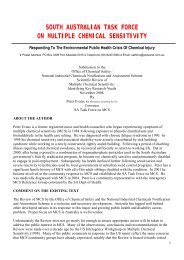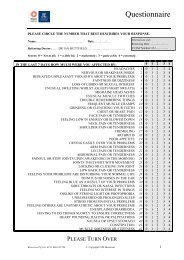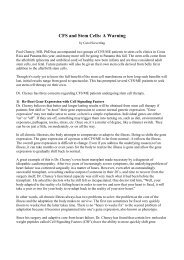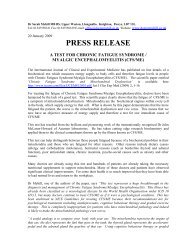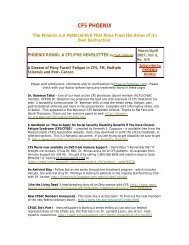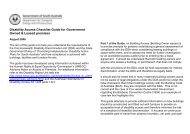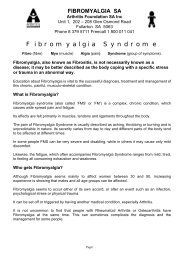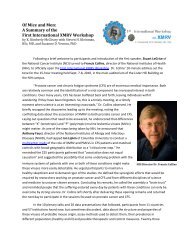4 M. Cazzola et al.(2). In the early 1980s, Yunus replaced “fibrositis”with “fibromyalgia” in order to underline the absenceof phlogistic alterations in the muscle thatwere repeatedly reported in published histologicalstudies (3). In 1990, under the aegis of the AmericanCollege of Rheumatology (ACR), a multicentrestudy of 558 patients with fibromyalgia wasconducted with the aim of standardising the diagnosticcriteria of the syndrome (4). This studyfound that the combination of pain induced by 4kg./cm 2 of pressure in at least 11 of the 18 consideredTPs and a history of diffuse musculoskeletalpain for at least three months provided the mostsensitive, specific and accurate criteria for diagnosingboth primary and secondary FM.However, the use of the 1990 ACR criteria in clinicalpractice soon highlighted their limitations; inparticular, they were not able to distinguish FMfrom other syndromes that are characterised by organor systemic symptoms without detectable morphologicalalterations, such as chronic fatigue syndrome(<strong>CFS</strong>) and myofascial syndromes (5-7).Many of these symptoms overlap to the extent thatthe same patient will often satisfy the diagnosticcriteria for two or more syndromes. In 1989, Popeand Hudson postulated the concept of a “spectrumof affective disorders” based on the observationthat many of these conditions showed a certain clinicalresponse only to antidepressants (8). Followingsimilar reasoning concerning the syndromes’clinical characteristics and mutual associations, andconsidering the most accredited pathogenetic hypothesesfor each, Yunus coined the definition of a“spectrum of dysfunctional syndromes” in whichthe term “dysfunctional” referred to the supposedunderlying psycho-neuro-immuno-endocrine alterations(9). More recently, these attempts at classificationhave been questioned and supplanted bythe concept of a “central pain syndrome” or, better,“central sensitisation” (10, 11). Central sensitisationis based on the latest experimental evidenceconcerning the role that central nervous systemmodifications, which are induced by the environmentin genetically predisposed subjects, play inthe onset of many previously defined “algodysfunctional”syndromes, including FM (12).DEFINITIONIn 1989, Wolfe defined FM as “a painful musculoskeletaldisorder characterised by core clinicalfeatures that are always present (widespread chronicpain and tenderness), features that are present inmore than 75% of cases (fatigue, non-refreshingsleep and morning stiffness), and features that arepresent in more than 25% of cases (for example,paresthesia, irritable bowel syndrome and functionaldisability)” (13). Constitutional symptomshave not been considered since the 1990 ACR diagnosticcriteria; and the main symptom that distinguishesFM is now pain, which must be diffuse(affecting both sides of the body, above and belowthe waist, and the axial skeleton involving at leastone of the cervical, dorsal and lumbar regions of thespine), chronic (present for at least three months),and capable of being evoked by pressure at specificsites (TPs) (4). In our view, developments in ourknowledge of the pathogenetic mechanisms of thecentral pain syndromes, together with the reducedimportance of TPs for diagnostic purposes, now allowthe definition to be reformulated as follows:“Fibromyalgia is a central sensitisation syndromecharacterised by dysfunctions in the neurocircuitsinvolving the perception, transmission and processingof nociceptive afferents, with the prevalentmanifestation of pain at the level of the musculoskeletalsystem. In addition to pain, there may bea multitude of accompanying symptoms (asthenia,sleep disturbances, abdominal pains…) that arecommon to other central sensitisation syndromes.Particular genetic characteristics and a reduced individualcapacity to tolerate “stressors” predisposeindividuals to the onset of the disease”.DIAGNOSTIC CRITERIAIn 1990, the ACR carried out a study involving 558FM patients attending 16 centres with the aim ofstandardising the syndrome’s diagnostic criteria(4); this study identified the most sensitive, specificand accurate criteria for diagnosing FM:1) A history of widespread pain: chronic, widespread,musculoskeletal pain lasting longer thanthree months in all four quadrants of the body(“widespread pain” was defined as pain above andbelow the waist, and on both sides of the body),with the additional presence of axial skeletal painin the cervical spine, anterior chest, thoracic spineor low back.2) Pain in 11 of 18 tender sites upon digital palpation:there are 18 TPs that doctors assess to confirmthe diagnosis of FM (see Figure 1), and accordingto the ACR requirements, a patient must
Fibromyalgia syndrome: definition and diagnostic aspects 5A) Occiput: bilateral, at the suboccipital muscle insertions.B) Low cervical: bilateral, at the anterior aspects of the intertransversespaces at C5-C7.C) Trapezius: bilateral, at the midpoint of the upper border.D) Supraspinatus: bilateral, at origins, above the scapula spinenear the medial border.E) Second rib: bilateral, at the second costochondral junction, justlateral to the junctions on upper surfaces.F) Lateral epicondyle: bilateral, 2 cm distal to the epicondyles.G) Gluteal: bilateral, in upper outer quadrants of buttocks in anteriorfold of muscle.H) Greater trochanter: bilateral, posterior to the trochantericprominence.I) Knee: bilateral, at the medial fat pad proximal to the joint line.Figure 1 - Fibromyalgia tender points identified by the American Collegeof Rheumatology in 1990 (at digital palpation with an approximateforce of 4 kg).endorse at least 11 as painful upon application ofapproximately four kg/cm 2 of pressure.As the ACR criteria suggest, a diagnosis of FM requiresthe “hands-on” evaluation of a patient by askilled medical professional, typically a rheumatologist,although other specialists are becomingquite knowledgeable in this area. Patients are usuallyaware of the specific anatomical origins of thepain in their bodies; however, self-diagnosis is notadvised.The authors also stated that, from a clinical perspective,primary and secondary FM were indistinguishableand, therefore, they proposed abolishingthe term “secondary fibromyalgia”. A diagnosisof FM may be present concomitant with otherrheumatic diseases, but in this way, the “secondary”FM remains clinically indistinguishablefrom the primary form and is an unnecessary classification.In the absence of diagnostic laboratory tests or X-rays, the ACR diagnostic criteria were a milestonein the recognition and study of FM. For the firsttime, researchers around the world could identifyand study FM patients using standardised measures,thus enabling comparison of results. In the clinicsetting, patients who had fallen through the cracksof medical science could finally be diagnosed.Nevertheless, the criteria were not without theirdrawbacks:• the TP paradigm suggested that FM patients onlyexperienced pain in anatomically-specificsites, but later studies (such as those reported byGranges and Littlejohn in 1993) suggested thatthey were sensitive to painful stimuli throughoutthe body. Today, widespread body pain is commonlyassociated with FM (14);• it quickly became evident that tenderness variedfrom day to day and from month to month, whichmeant that TP counts fluctuated above and belowthe required 11 depending on when the countwas made. Furthermore, patients did not alwaysmanifest pain in all four body quadrants: somehad unilateral pain, and/or pain solely in the upperor lower half of the body;• Staud has shown that, although everyone withFM has TPs, the number of TPs does not reflectthe level of pain patients experience; in short,TPs do not correlate with pain (15);• Clauw and Crofford have commented that theACR criteria focus only on pain and do not includemany other FM symptoms (fatigue, cognitivedisturbance, irritable bowel syndrome, etc.);as a result, the criteria “fail to capture the essenceof the FM syndrome” and allow for “greater variabilityin studies of physiologic mechanisms otherthan pain processing” (16);• the number of TPs is greatly influenced by thedemographic and psychological characteristicsof patients with FM. Women are only 1.5 timesmore likely to experience chronic widespreadpain but are 11 times more likely to have 11 ormore TPs, which means that they are approximately10 times more likely to satisfy the ACRcriteria. However, most men who experiencechronic widespread pain but are not tender
- Page 2 and 3: 2 P. Sarzi-Puttini et al.The meetin
- Page 6 and 7: 6 M. Cazzola et al.enough to meet F
- Page 8 and 9: 8 M. Cazzola et al.Table I - Charac
- Page 10 and 11: 10 M. Cazzola et al.Table IV - Cond
- Page 12 and 13: 12 M. Cazzola et al.teria, three su
- Page 14 and 15: 14 M. Cazzola et al.tients with a n
- Page 16 and 17: 16 G. Cassisi et al.The cardinal fe
- Page 18 and 19: 18 G. Cassisi et al.StiffnessIn FM
- Page 20 and 21: 20 G. Cassisi et al.Autonomic and n
- Page 22 and 23: 22 G. Cassisi et al.Associated symp
- Page 24 and 25: 24 G. Cassisi et al.46. Coleman RM,
- Page 26 and 27: 26 S. Stisi et al.sensitization,”
- Page 28 and 29: 28 S. Stisi et al.Sum oflife-events
- Page 30 and 31: 30 S. Stisi et al.trols, they prese
- Page 32 and 33: 32 S. Stisi et al.stress, obtained,
- Page 34 and 35: 34 S. Stisi et al.50. Harris RE, Cl
- Page 36 and 37: ORIGINAL ARTICLEReumatismo, 2008; 6
- Page 38 and 39: 38 F. Atzeni et al.lalanine (17), a
- Page 40 and 41: 40 F. Atzeni et al.clearer and it m
- Page 42 and 43: 42 F. Atzeni et al.healthy control
- Page 44 and 45: 44 F. Atzeni et al.and/or verbal (e
- Page 46 and 47: 46 F. Atzeni et al.for study purpos
- Page 48 and 49: 48 F. Atzeni et al.mimics of fibrom
- Page 50 and 51: ORIGINAL ARTICLEReumatismo, 2008; 6
- Page 52 and 53: 52 P. Sarzi-Puttini et al.A larger
- Page 54 and 55:
54 P. Sarzi-Puttini et al.from 1966
- Page 56 and 57:
56 P. Sarzi-Puttini et al.rational,
- Page 58 and 59:
58 P. Sarzi-Puttini et al.49. Toffe
- Page 60 and 61:
60 R. Casale et al.cal exercise and
- Page 62 and 63:
62 R. Casale et al.definition of
- Page 64 and 65:
64 R. Casale et al.are more or less
- Page 66 and 67:
66 R. Casale et al.trol associated
- Page 68 and 69:
68 R. Casale et al.32. Lewit K. The
- Page 70 and 71:
ORIGINAL ARTICLEReumatismo, 2008; 6
- Page 72 and 73:
72 L. Altomonte et al.In a clinical
- Page 74 and 75:
74 L. Altomonte et al.Table II - We
- Page 76 and 77:
76 L. Altomonte et al.treatments de



